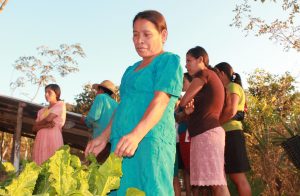Camotan, Guatemala, Dec 8 (EFE).- About a decade ago, the “rain began to fail” one May and summer came early in the Guatemala’s impoverished Dry Corridor. Since then, scanty precipitation has hurt the local harvests, but local peasant farmers have found a solution: they have learned to harvest the rain.
When it comes, they funnel the rain into a gutter leading to a basin fitted with a lining that allows them to save the water to use for irrigation during the four summer months.
“The aim is to preserve life during the dry season,” said the United Nations Food and Agricultural Organization representative in Guatemala, Diego Recalde.
A few months ago, they installed a basin in the village of Pitahaya, in the stark mountains of Chiquimula province, one of the regions where people are hardest hit by chronic malnutrition.
Some 43.4 percent of the people there are malnourished, but in some of the more isolated communities the figure is 70 percent.

Today, despite the dry climate, a small garden is being tended next to the basin where radishes, cilantro, chard and other items are grown.
“It’s important to help the children,” said Celia Margarita, an elderly woman who each day comes to the community to find out how to set up and manage a garden.
“We want to learn to fish, not to have them give us a fish,” said Maria Elena, another woman attending the Cader rural development learning center sponsored by the Guatemalan government with international cooperation.
By 5 pm, most of the women have been outside the home all day. Sometimes they have to leave at 3 am to find water, one of the young ladies who came to the garden said.
Ana Vazquez, slender and pregnant, is one of the lucky ones – it only takes her half an hour to get to the learning center and there she proudly told EFE that she has learned techniques for growing things in her own home garden.
Up to now, people in the Dry Corridor have been eating the same thing for breakfast, lunch and dinner – tortillas with salt – a diet completely inadequate for children’s normal development.
“We’re fighting against the malnutrition of the children,” Ana Vazquez admitted.
Coffee beans can be grown in the highest areas of the region, but there’s not enough water there, and growing corn and beans is also problematic.
But with the rainwater collection basin the local populace now has dietary alternatives – vegetables, fruits and other things that they grow themselves to provide their families with better nutrition.
And now they’re even trying to grow mangos to market them, but for the effort to pay off they need more rainwater basins.
